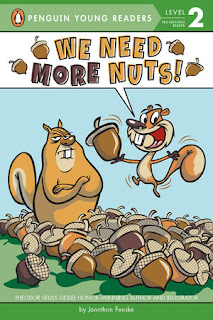
With the selection of We Are Growing! by Laurie Keller as
the 2017 Geisel Medal Winner, the understandably high expectations for Mo
Willems’ Elephant & Piggie Like Reading! imprint solidified into something
weighty. Will one (or both) of the 2017 additions to this imprint prove worthy
under the lens of Geisel scrutiny and impress this year’s committee?
Both The Good for NOTHING
Button! and It’s Shoe Time!
include several of the design elements we’ve come to expect from a book endorsed
by Piggie and Gerald. Color coded word balloons to distinguish who is speaking,
use of repetition as a key component of the humor, and a respectably large font
size are all choices that support the success of a beginning reader. Stylistically,
the serif font that uses both typeface a’s and g’s and the leading and line breaks
appear to be chosen for more fluent readers than the font size would suggest, but largely the formula this imprint draws from
the techniques perfected by the Elephant & Piggie series creates the
opportunity for successful reading experiences.
It’s Shoe Time! by
Bryan Collier brings to beginning readers the incredible talents of Bryan
Collier – a six time recipient of the Corretta Scott King Award and a four time
recipient of both Coretta Scott King and Caldecott Honors. #WeNeedDiverseBooks
for beginning readers, and while It’s
Shoe Time! is centered on the experiences of the shoes on the cover, the
two human characters are a confident Black girl and her father portrayed with
Bryan Collier’s remarkable artistic style. The human family is featured in
approximately a quarter of the book, with the rest focused squarely on our
wisecracking shoes.
Strengthening the appeal for those second graders at the top
of the Geisel age range is a preponderance of wordplay throughout. Many second
graders enjoy wordplay (think knock-knock jokes) as they build their reading
confidence, and the Sneakers in particular deliver throughout the text with groaners
like “We are afraid . . . KNOT!”, “That was sneaky!”,
and “They got left behind. Get it?”
all while providing their own laugh track of Hees and Has scattered across the
pages. Use of all caps and italics emphasize the puns in these lines, but those
stylistic choices as well as the many scattered Hees and Has indicate that this
is a read for a more fluent young reader. An emergent reader may need to read
each of those Hee Hees and Has individually, slowing the pace of the book, as
they cannot at a glance determine that they are all the same word in the way an
older reader would. There are new vocabulary words introduced without an
accompanying illustration to serve as a key, as is the case with “I HOOF TO
KNOW!” during a Piggie and Gerald interlude midbook. Collier’s art style appears
to have been simplified for this audience, which is a strength when evaluated from
a Geisel perspective – the illustrations are in balance with the text while
still recognizably the artist’s work.
From the opening spread, The
Good for NOTHING Button! supports the emergent reader. Where It’s Shoe Time
opens in the darkness of the closet with only the PAT! PAT! sound of approaching feet and a variety of word balloons to
set the scene for readers, The Good for NOTHING
Button! immediately introduces every character in the book (the three
birds, the button, and the worm providing commentary) and squeezes repetition into the 1,2, and 3-word sentences on the
page. The simplicity of the tableaus is very reminiscent of the strengths of
the Elephant & Piggie titles on some pages, with minimal backgrounds and
plenty of white space. The repetition, introduces on the very first page, is a
strong component of the text here on scales large and small. In one instance “Nothing”
is included 4 times across a single page turn (from pages 7-9), and longer
sentences are often mitigated by large amounts of exact repetition. (page 10) “May
I press the button?” “Yes, Blue Bird. You may press the button.” Even the
structure of the story includes some repetition to help young readers follow
the plot, with the repeated conclusions that “ ______ is NOT nothing”.
Nothing is a sophisticated concept. The idea of zero as it
relates to math skills is introduced in numerous ways to young learners, so it’s
delightful to see the concept centered in this humorous book for beginning
readers. The emotional awareness modeled in the text aligns with skills that
preschoolers and kindergartners are developing. As an adult reader I
particularly appreciated that it was the fellow birds pointing out the
emotional impact of the button based on their observations, even when the
button-pusher was not yet aware of their own response.
The humor in this title seems to particularly reflect the
influence of Mo Willems’ work - from the presence of highly emotive birds to
friends engaging in repetitive silliness (see pages 45-47 for “Funny!Funny! Funny!/Button!Button!Button!/Crash!”).
Of the two titles, were I on the committee I would be more
inclined to include The Good for NOTHING
Button! as one of my nominations for this year. Logistically speaking it has been out
for much of the year so I would have been more likely to see beginning readers
interact with it, and of the two I would expect it to work better for a wider
range of less fluent readers. However, I’d be very eager to see how more
confident readers handle the wordplay of It’s
Shoe Time! and would be open to incorporating both if I saw compelling
evidence that it works for its intended audience – there’s enough variance in
their presentation, content, and intended age range that I think each stands
out as a distinct contribution to the field.
 |
| Picture from Kidlitfrenzy.com |


































